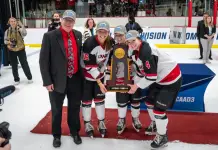The obvious story of last weekend was the East Regional. RIT made it through and will play in the Frozen Four. The MVP of the East Regional should have been the RIT fans.
The NCAA should take a really good look at this. Bracket integrity sounds nice, but one of the reasons that RIT won this regional was its fans. They were all in orange, they were loud and they brought Ritter Arena to Albany, N.Y. Don’t underestimate how that home ice advantage was a huge factor against No. 1 seed Denver on Friday and again on Saturday against New Hampshire.
If RIT was in St. Paul, Minn., (like Vermont was) it could have been dead in the water. The Tigers would have played Wisconsin in a building four hours from Madison, and you can make a case that would have been a tough hill to climb. That takes nothing away from their tremendous achievement but it does underscore that if you want a Cinderella story, she’d better be at a ball close to home where her fans can see her dance.
There are some tremendous stories coming out of RIT, the best being Detroit native Cameron Burt returning to his hometown to play in the Frozen Four. A Detroit kid whose family has season tickets to the Lions and who sports a Detroit Tigers Olde English “D” tattoo on his arm, Burt will get a chance to live out a dream and play for a national title in his hometown.
The second interesting story is the weekend turned in by Hobey Baker Award candidates. This was the last weekend for them to make an impression, and some probably helped their cause while some didn’t.
Chase Polacek of RPI and Gustav Nyquist of Maine were not in action. The Wisconsin duo had pretty good weekends as the Badgers advanced to the Frozen Four. Blake Geoffrion had two goals and five points for Wisconsin (16 shots on goal) and Brendan Smith had two assists. Bobby Butler had a dominating game against Cornell for New Hampshire in the East Regional semifinals with a goal and two assists, but he wasn’t effective against RIT.
The goalies were an interesting story. Marc Cheverie was very good in the loss to RIT. The first goal he gave up was off a defensive-zone turnover and he was partially screened on the 35-foot wrister, one of those “puck had eyes” goals. The other goal against was on a redirected pass on the power play.
Ben Scrivens struggled against UNH. The first goal was reviewed for about 15 minutes. The shot by Butler went through the net and play needed a whistle to stop and review it.
There was no question on the replays that the puck went through the net, and the in-house replays showed as much. UNH was celebrating five minutes before the announcement of the goal was made. That seemed to rattle Scrivens, who was great to that point. After the goal was awarded, UNH came down on its next shift and Mike Sislo scored on a shot that Scrivens should have had. He was in the right place, played it well, but the shot crawled up on his body and past him for a 2-1 UNH lead. He was toast after that, but Cornell wasn’t very good from that point on, either.
Miami’s Cody Reichard stopped 16 shots against Alabama Huntsville in a 2-1 win. Then he didn’t play against Michigan in the regional final, instead watching his goaltending partner Connor Knapp turn in a performance for the ages in a double-overtime win to get Miami back to the Frozen Four. Miami is all about team and Reichard is part of “The Brotherhood” at Miami. Individual awards don’t matter much to that bunch, and Reichard probably didn’t help or hurt himself this weekend.
The two who probably dropped a bit were Mark Olver of Northern Michigan and Rhett Rakhshani of Denver. The Pioneers ran into a hot goalie against RIT, but as the go-to guy for the top-seeded team Rakhshani needed to be a bigger factor in the game than he was. The kid had a tremendous career but it ended a little too quietly. He had six shots in the game and was even. Olver had a good game against St. Cloud State, setting up the game-tying goal to force extra time in a double-overtime loss.
The Michigan-Miami game was the game of the weekend as these two CCHA rivals met again for their second time in two weekends. They last met in Detroit in the CCHA semifinals, a game won by the Wolverines. This game was what college hockey is about. The officials got in the way a bit during regulation, probably the only game of the weekend where they were noticeable. The waved-off overtime goal for Michigan was a shaky call at best. It isn’t the first blown call in that situation and it won’t be the last, but that’s part of the equation. Miami won how it usually does, with one of its unsung guys making a big play at a big moment.
Michigan is still the best story of the season. Shawn Hunwick in goal had a magical ride through the end of the season and playoffs, and that makes for an interesting training camp next September. The kid was great. His emotional even keel in games was a huge aspect to Michigan getting as far as it did. You should never lose your job to an injury, and Bryan Hogan should be the No. 1 when camp opens but he’ll have to really earn it this September. This could be just what Hogan needed.
Hogan is a solid goalie but now with Hunwick proven it makes Hogan be on his toes every game because much like Jose Theodore found out in Washington last year in the playoffs after one bad game, once the reins are handed over to someone else they might not come back. Hogan’s brilliant performance in the Frozen Four semifinals against Notre Dame two years ago in Denver in relief of Billy Sauer turned the tide his way. That tide never turned until he got hurt.
Hogan will be ready for his senior season, and after watching the playoffs from the stands, he should be mentally and emotionally charged to make sure every game in his last year at Michigan keeps him the No. 1 guy. He’s too competitive for this upcoming campaign not be his best season.
Speaking of the Midwest Regional, tremendous job and kudos to former CBS College Sports broadcast partner Ben Holden, who was off the charts good calling that final game. Sean Ritchlin was also solid as the analyst. They got a great game to call and enhanced it very well.
Speaking of enhancing, programs are still looking for a head coach to better enhance their chances of playing in the national tourney. There are a lot of great CCHA assistants out there who would make great head coaches. Tom Newton, Brian Renfrew, Mel Pearson, Billy Powers and Chris Bergeron are in that mix, just to name a few. Casey Jones seems a good choice for Ohio State. John Markell could be a good fit at Bowling Green. Wisconsin assistant Mark Osiecki would probably be a great choice for Ohio State.
I’m throwing one at you that would make a great head coach at a school like OSU and that is former Clarkson coach Mark Morris. “Mo” has had tremendous success since his dismissal from Clarkson at the prep and AHL level and his track record for player development in Manchester of the AHL is pretty good. He did well at Clarkson, well in the OHL, well at Northwood Prep and well with the Monarchs. I couldn’t tell you if this thought has crossed his mind but if I was an AD this would be a guy who I’d make a phone call to. His accomplishments with the Los Angeles Kings’ minor-league team are worth a look.
The last issue to tackle is attendance. There were lots of TV pictures of empty buildings. Not good for credibility. The season features many games televised in buildings that are jam packed. This was embarrassing.
How do we fix this?
The prevailing thought among many coaches, sports information directors and players I have talked to about this in the past couple of years is to put regionals back on campus. A 5,000-to-7,000-seat venue is probably what you need to make this look good, and to do it on campus would probably help. Also, make sure youth hockey organizations are involved. Get them good ticket packages. They are your future players; hook them early.
I’ll take this one step further, and you will hate this idea, but here goes. Have the schools bid on hosting the regionals. If you host in one year you can’t host again for another four years to spread this around. Then — and here is the kicker you won’t like — let the host team into the regional automatically to guarantee attendance. It’s the Memorial Cup theory, but it works pretty well in major junior.
This is still a theory in the development stages, but here is a hypothetical scenario.
Let’s say the host sites are Yost Ice Arena (Michigan), Agganis Arena (Boston University), Magness Arena (Denver), and TD Bank Sports Center (Quinnipiac).
If Michigan, Denver, BU or Quinnipiac do not get an automatic bid or an at-large bid, they still get into their regional as the No. 4 seed. If they do get in on their own merit, then the selection of the other three teams stays very much the same, though I’d be very careful as to where you are sending teams. We do not need another Alaska appearance in Worcester, Mass.
That could ruin things for one deserving team, but until Atlantic Hockey and the CHA started winning national tourney games you could have said the same about them getting in. Bemidji State and RIT made the Frozen Four, and we’ll never forget the Holy Cross upset of Minnesota or Air Force KOing Michigan, so no one will challenge that auto bid for the AHA at the expense of a name brand school.
Yes, you want to be fair to deserving teams but you also want to create a buzz for your product. Michigan-Miami was a classic, yet the attendance on a Sunday night in Fort Wayne, Ind. — more of a minor league town than a college hockey town — was similar to that of a preseason game.
You want and need that building packed, and you really need it played on a Saturday. That will lead me to my second rant, but give me a second here to finish the first. The bottom line is that campus sites will attract fans more so than these neutral sites that are almost always half empty. The rink in Albany is a dump. They would have been better off playing the games at RPI instead of the Times Union Center.
What was a good atmosphere would have been electric and potential college players of the future would see a scene that would make a lasting impression on them as one in which they would want to play. It is built-in recruiting; what a sales pitch. There are plenty of great buildings in college hockey that are packed every night. Use them in your showcase events like a regional.
Yet a question comes up. Would certain schools get shafted by never having a chance to host? It’s a great question. The Berry Center at Northern Michigan is a great building and the Carlson Center in Fairbanks is also. There is no chance these two schools could ever host a regional because getting there is a nightmare. This is where certain schools have a major advantage. Any school located near a major airport has a huge advantage. Notre Dame could host; it is 90 minutes from Chicago. Maine probably couldn’t based on this argument but New Hampshire could — it is in striking distance of Providence, Boston and Manchester.
Can you solve that? Yes. Northern Michigan can host a regional, but it just might be doing it at Michigan State. NMU can act as the host school, staff the event, get its team into it as the fourth team, but it is responsible. If you are a team in an area not conducive to a big gathering due to being somewhat remote, then partner up with a conference mate and use their building. That way the visiting “host” school gets what they want and the other school (in this case MSU) gets a percentage of the action and its campus becomes a showcase for any younger players attending the event or any high school kids at the event who are starting the college application process. For MSU, it would be free advertising.
Want to take this one step further for a great fit? Find out where the USA Hockey national championship tournaments are being played, as they are usually around this time. The Tier III Junior A, B, and C national tourneys were in eastern Massachusetts last weekend. Wouldn’t it be great to have those teams with chances to buy tickets to the regional tourney well in advance? Market to them if you aren’t already and see in the future if you could have the regionals coincide with the vast array of USA Hockey national championships going on nationwide.
A second question. Quinnipiac? Is the building big enough for a regional? It is a great facility and accessable from NYC’s two airports and also Hartford and even Boston or Providence, but is it big enough? It certainly would sell out.
Next up is when games are played. CBS Sports manages to do a great job with March Madness in the first round with games up against each other. In the Sweet 16 on championship days, games aren’t up against each other but hoops is different because the casual fan who fills out a bracket will watch Duke on a Sunday night.
The fact that Michigan-Miami started at 8 p.m. Eastern on a Sunday night was absurd. The game ended just before midnight; how many youth hockey players were watching? Better yet, I’ll bet not many youth hockey parents were still around when this one ended, and this was one of the best games played all year.
Now you have a challenge here on two fronts. One is what days to play and the second is how you schedule your championships to best serve your viewing audience.
Do you play all games Friday and Saturday? If you play Friday you might risk attendance for a 4 p.m. Friday game but then again you might not if it is known that far in advance when the game is and where. Put the host (in using my new theory for regionals) team in the 4 p.m. game and you might not have an issue. That gives you a Saturday of games with a Frozen Four bid on the line.
Or do you play all games Saturday-Sunday across the board but risk a Sunday night where you might lose some attendance? No matter what, you cannot have an 8 p.m. Sunday game in college hockey. You don’t play one all season; why would you do it now? It violates everything college hockey is about, and this is a sport that exemplifies destination television. You know every Friday and just about every Saturday night you can find a college hockey game on TV. You never look for one on Sunday. It just doesn’t work and you lose a key demographic: the kids.
The issue then becomes if all the games are on against each other, where do you put them on? Being in TV, I’m staying away from this one but will introduce an idea told to me by an executive producer at one of the regional sports networks. With so many RSNs and two national networks (CBS College Sports, ESPN) doing college hockey games all season, it might not be a bad idea to open the bidding to those who do it a whole lot sometime down the road. That way you have more people watching these games live and in places where they are used to finding them. It seems to work very well in the conference tournaments with that type of TV coverage.
You are going up against college basketball, however, and despite its ratings being down that’s still a great attraction to a television audience. Then again, hockey fans are not basketball fans from all of my experience in television. It is a much different demographic. Not that you want to take on the NCAA hoops tourney much like the NHL has to be careful going up against the NBA (or baseball starting as the playoffs start). Where you have an issue is advertising. Companies will be more likely to put advertising dollars into the hoops tourney and that could leave hockey broadcast outlets in trouble in terms of making televising the regionals financially viable.
Now, a question was brought up to me on this issue. Let’s say you have the regionals you had last weekend. Hypothetically, FS North gets the Minneapolis regional, FS Detroit could take the Fort Wayne regional, NESN takes the Worcester regional and CBS College Sports or ESPNU gets the Albany regional.
If you have a regional like a few years ago with Colorado Springs hosting, FS Rocky Mountain could bid for it. CBS College could go anywhere as a national. So could ESPNU. Reward those who have done it all year and have the people who have covered these teams all season do them when they most eyeballs are watching.
There is some food for thought. You are the fans of this great game. What would you like to see to help the business of college hockey? Your voice needs to be heard.


